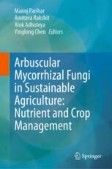Search
Search Results
-
Core hyphosphere microbiota of Fusarium oxysporum f. sp. niveum
BackgroundBacteria and fungi are dynamically interconnected, leading to beneficial or antagonistic relationships with plants. Within this...

-
Organic phosphorus levels change the hyphosphere phoD-harboring bacterial community of Funneliformis mosseae
The phoD -harboring bacterial community is responsible for organic phosphorus (P) mineralization in soil and is important for understanding the...

-
Exploring the secrets of hyphosphere of arbuscular mycorrhizal fungi: processes and ecological functions
BackgroundMost plants have a hyphosphere, the thin zone of soil around extraradical hyphae of arbuscular mycorrhizal (AM) fungi, which extends beyond...

-
Organic nitrogen utilisation by an arbuscular mycorrhizal fungus is mediated by specific soil bacteria and a protist
Arbuscular mycorrhizal (AM) fungi lack efficient exoenzymes to access organic nutrients directly. Nevertheless, the fungi often obtain and further...

-
An arbuscular mycorrhizal fungus alters soil water retention and hydraulic conductivity in a soil texture specific way
Arbuscular mycorrhizal fungi (AMF) alter plant water relations and contribute to soil structure. Although soil hydraulic properties depend on soil...

-
Does arbuscular mycorrhizal fungi inoculation influence soil carbon sequestration?
Whether arbuscular mycorrhizal fungi (AMF) inoculation promotes soil C sequestration is largely unknown. Here, meta-analysis and logistic regression...

-
Root Exudates and Their Importance in Arbuscular Mycorrhizal Symbiosis and Nutrients Navigation from Inaccessible Soil: An Efficient Mediator of Mineral Acquisition in Nutrient Deprived Soil
The growth and development of plants happen through internal molecular communications that rely on adequate nutrient supplements to roots from the...
-
A trade-off between space exploration and mobilization of organic phosphorus through associated microbiomes enables niche differentiation of arbuscular mycorrhizal fungi on the same root
Ecology seeks to explain species coexistence, but experimental tests of mechanisms for coexistence are difficult to conduct. We synthesized an...
-
Arbuscular mycorrhiza: advances and retreats in our understanding of the ecological functioning of the mother of all root symbioses
BackgroundArbuscular mycorrhizal (AM) symbiosis has been referred to as the mother of all plant root symbioses as it predated the evolution of plant...

-
Tropical tree ectomycorrhiza are distributed independently of soil nutrients
Mycorrhizae, a form of plant–fungal symbioses, mediate vegetation impacts on ecosystem functioning. Climatic effects on decomposition and soil...

-
Role of root hair elongation in rhizosheath aggregation and in the carbon flow into the soil
One of the most prominent changes in the rhizospheric soil structure is associated with the formation of a strongly bound soil layer in the...

-
Co-inoculation of AMF and Other Microbial Biofertilizers for Better Nutrient Acquisition from the Soil System
The synergistic interactions between rhizosphere microorganisms may be beneficial, harmful, or neutral for the plant and those effects can be varying...
-
Soil controls on carboxylate-driven processes and opportunities
Through their influence on microbial processes, carboxylates exuded by roots are key drivers of nutrient acquisition and organic carbon (C) storage...

-
Agronomic Practices for Optimizing the AMF Abundance and Diversity for Sustainable Food Production
The chapter emphasizes the critical role of arbuscular mycorrhizal fungi (AMF) in addressing soil fertility degradation caused by global climate...
-
Soil organic phosphorus is mainly hydrolyzed via phosphatases from ectomycorrhiza-associated bacteria rather than ectomycorrhizal fungi
Background and aimsMycorrhizal fungi-released phosphatases have long been claimed pivotal to mobilize soil organic phosphorus (P). We hypothesized...

-
Phosphorus forms affect the hyphosphere bacterial community involved in soil organic phosphorus turnover
Interactions between bacteria and arbuscular mycorrhizal (AM) fungi play a significant role in mediating organic phosphorus (P) transformations and...

-
Tree mycorrhizal types and the interaction between tree and shrub species richness shape soil fungal communities in a subtropical forest in China
PurposeElucidating the interactions of above- and below-ground communities in forest ecosystems is of great importance for comprehending biodiversity...

-
Microbial Consortia: An Approach to Enhance the Effectiveness of Beneficial Soil Microbes
Chemical inputs likes pesticides and fertilizers are widely used in agriculture today, but they affect soil health and its nutritional value. Since...
-
Effects of Organic Agriculture on the Soil Carbon Stock
The soil carbon (C) stock is comprised of the soil inorganic carbon (SIC) and the soil organic carbon (SOC) stock. A site-specific steady state...
-
Mushroom Metagenome: Tool to Unravel Interaction Network of Plant, Mycorrhiza, and Bacteria
In a world of scientific breakthroughs, the solution to our most pressing problems could be right under our noses – microbes. The rhizospheric...
